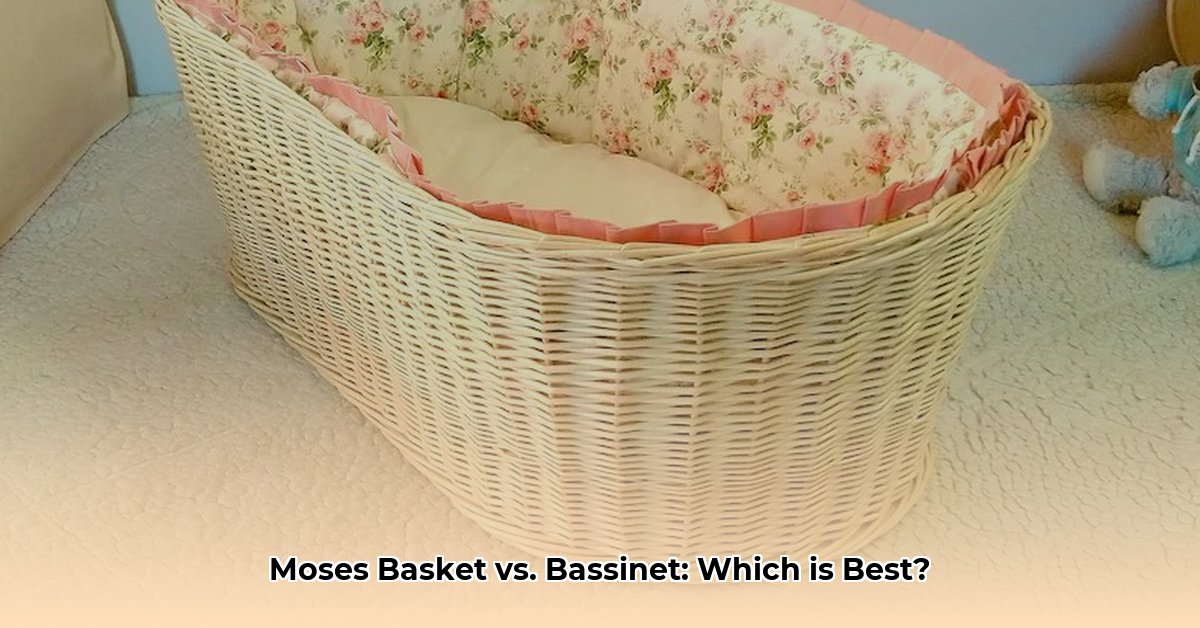Choosing the perfect first bed for your baby can feel overwhelming. This guide compares Moses baskets and bassinets, explaining their differences and helping you make an informed decision. We’ll cover everything from safety recommendations to transitioning to a crib, empowering you to create a cozy and secure sleep haven for your little one.
Moses Baskets: Cozy & Portable
A Moses basket is a small, lightweight baby bed, often made of woven materials like palm, wicker, maize, or sometimes fabric. Its defining features are its portability and compact size. Those convenient handles? Perfect for moving baby (while they’re still sleeping!) from room to room. A Moses basket is ideal for newborns up to around 4 months, or until they show signs of rolling or sitting up, or reach the manufacturer’s weight limit (typically around 15-20 pounds).
Bassinets: Versatile & Feature-Rich
“Bassinet” is a broader term encompassing various types of infant beds. While a Moses basket is a type of bassinet, there are also many other styles. Bassinets tend to be larger than Moses baskets and come with more features, such as rocking motions, storage space, and adjustable heights. They’re made from diverse materials, including wood, metal, plastic, and wicker, offering a range of aesthetics to match your nursery.
Moses Basket vs. Bassinet: A Side-by-Side Comparison
This table summarizes the key differences between Moses baskets and bassinets:
| Feature | Moses Basket | Bassinet |
|---|---|---|
| Size | Smaller, more compact | Larger, more spacious |
| Portability | Highly portable, lightweight | Less portable, some models have wheels |
| Lifespan | Up to ~4 months (or weight/mobility limit) | Potentially longer (up to 6 months or weight/mobility limit depending on the model) |
| Features | Typically includes handles for carrying | May include rocking, storage, adjustable height |
| Materials | Woven (palm, wicker, maize), fabric | Wood, metal, plastic, wicker |
| Price | Generally lower | Generally higher |
Safe Sleep is Paramount: Guidelines for Both
Whether you choose a Moses basket or a bassinet, safe sleep practices are crucial. Here’s what experts like the American Academy of Pediatrics (AAP) recommend:
- Back to Sleep: Always place your baby on their back to sleep, which greatly reduces the risk of SIDS.
- Firm, Fitted Mattress: Ensure the mattress fits snugly in the basket or bassinet, leaving no gaps.
- Clear the Crib: Keep the sleep space free of loose blankets, pillows, bumpers, and toys to prevent suffocation.
- Supervise Your Baby: Never leave your baby unsupervised in a Moses basket, especially on a stand. With bassinets, supervision is also crucial, particularly as your baby becomes more mobile.
- Stable Surface: Place the Moses basket or bassinet on a firm, level surface away from windows, cords, and furniture that could be climbed.
While the AAP provides widely accepted guidelines, ongoing research suggests exploring other credible sources and cultural practices for a comprehensive understanding of infant sleep safety.
Setting Up & Using Your Moses Basket or Bassinet
Setup is generally simple for both. Always refer to the manufacturer’s instructions. For Moses baskets, ensure the stand (if used) is stable. For bassinets, familiarize yourself with any additional features.
Transitioning to a Crib: When & How
When your baby starts showing signs of rolling, sitting, pulling up, or reaches the weight/height limit of their Moses basket or bassinet (usually around 4-6 months), it’s time to transition to a crib. Making the transition gradual can help your baby adjust. Some parents find it helpful to place the bassinet or Moses basket inside the crib for a few nights to ease the change.
Choosing the Right Option for You
The best choice depends on your lifestyle and needs. A Moses basket is great for smaller spaces, portability, and tighter budgets. A bassinet offers more features and potentially longer use. Consider your living situation, how often you’ll be moving the baby’s sleep space, and your budget when making your decision.
Frequently Asked Questions
Here are some common questions parents have:
- Do I need a stand for a Moses basket? A stand is optional but can make it easier to reach your baby. Always ensure the stand is stable and never leave your baby unattended on a stand.
- What type of mattress should I use? Use a firm, flat mattress specifically designed for Moses baskets or bassinets.
- Can I buy a used Moses basket or bassinet? While it might be tempting to save money, ensure any used product meets current safety standards and is in good condition. Check for recalls and thoroughly inspect the frame, mattress, and any other components.
- Where can I find more information on safe sleep? The American Academy of Pediatrics (https://www.healthychildren.org/) is an excellent resource for up-to-date safe sleep guidelines.
Conclusion
Choosing between a Moses basket and a bassinet is a personal decision. By understanding the key differences and prioritizing safe sleep, you can create a nurturing and secure sleep environment for your newborn. We encourage you to further explore the provided resources and consult with your pediatrician to address any specific concerns and make the best choice for your family.
- Glass Tile: Brighten Your Home With Stylish Glass Backsplashes - December 3, 2025
- Glass Backsplash: Ideas For a Stylish Kitchen Update - December 2, 2025
- Glass On Tile: A Stylish Kitchen Backsplash Option - December 1, 2025










